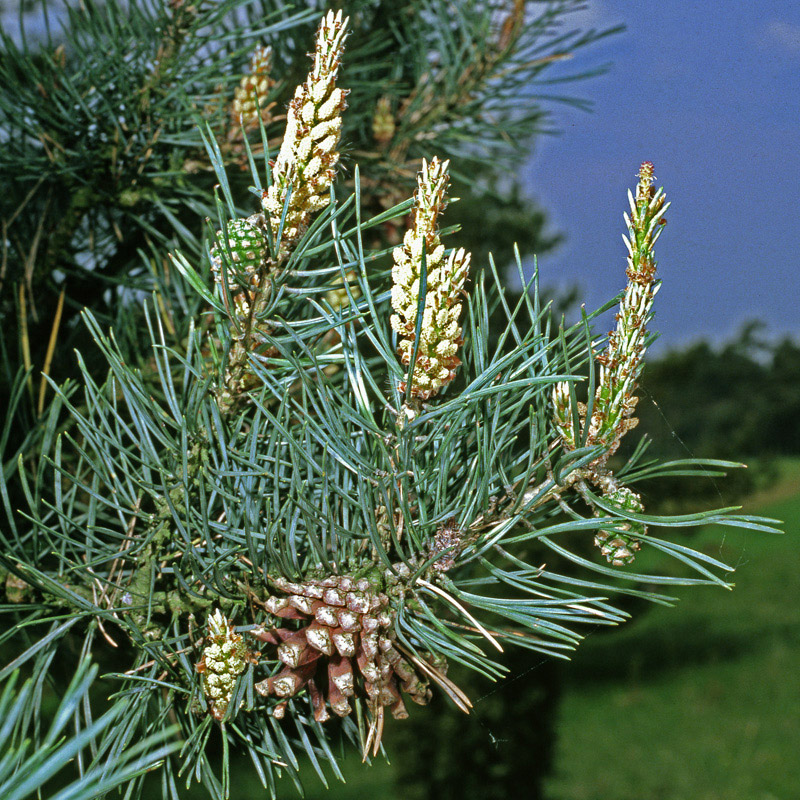Botanical name
Pinus sylvestris L.
Family
Pinaceae
Common name
Scots Pine, Scotch Pine, European Red Pine, Baltic Pine
Information about the plant
Due to its tolerance of water, soil, and air conditions, and its resin-rich varieties, the pine tree is an important species in European forests. It is widespread throughout large parts of Europe: in Scandinavia up to the 70th parallel, in the south extending to the Sierra Nevada, in the east across the Caucasus to Asia Minor, and through Siberia to the Amur region. It is also found at higher altitudes in the Alps. It forms extensive forest areas, which explains the name of the species epithet sylvestris, derived from the Latin “silva” (= forest) and “silvestris” (= of the forest, wooded, living in the forest); Linnaeus spelled it “sylvestris” according to the custom of his time, but both spellings are used today.
The trunk of the pine tree grows up to 40 m high and is branch-free to a considerable height in older specimens, forming an umbrella-shaped crown. The bark of young Scots pines is fox-red and peels off thinly, while in older trees it is gray-brown on the outside and rust-red and cracked on the inside, peeling off in pieces, i.e. a thick, scaly bark. The needles of the pine tree are 5 to 10 cm long and covered with wax on the inside. They grow in pairs on short shoots that cover the branches like a bottle brush. The pine tree flowers every year, and in the second year after flowering, the seeds develop in conical cones that hang singly or in clusters from the branch. In autumn, cones can be found beneath the tree.
Medicinally used parts of plants (herbal drug)
The pine shoots (Pini turiones), consisting of fresh or dried shoots, 3 to 5 cm long, collected in spring, and the essential oil obtained from fresh needles and twigs by steam distillation (pine needle oil – Pini silvestris aetheroleum), are used.
Constituents of the herbal drug
Pine shoots contain essential oil, resins, flavonoids, and bitter compounds. Pine needle oil consists of over 80% monoterpene hydrocarbons: pinene, Δ3-carene, myrcene, limonene, camphene, etc. It also contains oxygenated monoterpenes (bornyl acetate, etc.) and sesquiterpenes (including caryophyllene, α-humulene, germacrene D).
Quality of the drug
There is no pharmacopoeial quality description available for pine shoots (Pini turiones).
The quality of pine needle oil (Pini silvestris aetheroleum) is specified in the European Pharmacopoeia (Ph. Eur.).
Medical applications
Recognised medical use
Pine shoots and pine needle oil have not been evaluated by the HMPC or ESCOP.
Traditional use
Pine shoots and pine needle oil have not been classified as traditional medicinal products (Article 16a of Directive 2001/83/EC).
Herbal drug preparations in finished dosage forms
Pine shoots are used in syrups and tinctures. Semi-solid preparations with extracts are used for external applications.
Pine needle oil in alcoholic solutions (also a supplement to rubbing alcohol), ointments, creams, emulsions, oils, and baths (for colds) are used externally.
Dosage
Finished medicinal products: See patient information leaflet.
Pine sprouts
2 to 3 g of pine sprouts several times a day. Preparations as described.
Pine needle oil
Internal use: Take 3 to 4 drops of pine needle oil on a sugar cube or in water several times a day.
External use: For inhalation, add a few drops of pine needle oil to hot water and inhale. For baths, add 5 g of oil to a full bath (35–38°C) and bathe for 10 to 20 minutes.
Preparation of a tea
Not applicable.
Notes
Pine needle oil should not be used for bronchial asthma or whooping cough, and never near the eyes.
In infants and young children up to 2 years of age, pine needle oil can cause glottis spasms (laryngospasm), which, in the worst case, can lead to respiratory arrest. Therefore, never apply pine needle oil to the face! As a precaution, the use in children up to 4 years of age is not recommended.
Do not use baths in cases of major skin injuries, inflammatory skin diseases, fever, heart failure, or high blood pressure.
Side effects
Irritation of the skin and mucous membranes.
Interactions
None known.
References
Herbal drug monographs
None available.
Further literature
Commentary on the European Pharmacopoeia (Pine needle oil, No. 1842)


